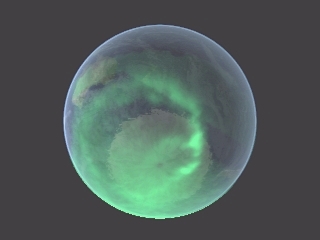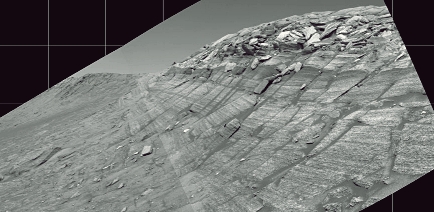 (The Earth/La Terre)
(The Earth/La Terre)  (Mars/Mars)
The Southern Auroral Oval / A Martian Crater Wall. Auroras -also called "northern lights"- are due to the interaction between Earth's magnetosphere and the solar wind. The magnetosphere is protecting us from the solar harmful radiation. The magnetosphere is this well known tear drop-shaped envelope extending on the far side of Earth, from the Sun. At Earth's both poles, the solar plasma however is managing to leak, and to reach Earth's upper atmosphere. This is triggering the aurora, these curtains of colored light seen at high latitudes. Auroras are "northern lights" North, and "southern lights" in the southern hemisphere. As the interaction between the solar wind and the magnetosphere is mostly continuous, its imprint may be seen over Earth's both poles. This is called the "auroral oval", hovering at about 68 miles (110 km) of altitude. Seen here is the southern auroral oval , with Australia top left, and the mass of the south polar cap. The auroral oval is generating the day-to-day auroras. On the other hand, more activity at Sun is increasing the activity at the oval. When the remnants of an energetic solar events are reaching Earth, the oval is more active, as it expands too. Auroras, then, are more spectacular as they may be seen farther South -or North, than usual. During such magnetic storms, the aurora, in the USA, may be seen as far South as Arizona. The auroral oval seen here is an expanded oval, due to a geomagnetic storm. picture courtesy NASA/UC Berkeley
(Mars/Mars)
The Southern Auroral Oval / A Martian Crater Wall. Auroras -also called "northern lights"- are due to the interaction between Earth's magnetosphere and the solar wind. The magnetosphere is protecting us from the solar harmful radiation. The magnetosphere is this well known tear drop-shaped envelope extending on the far side of Earth, from the Sun. At Earth's both poles, the solar plasma however is managing to leak, and to reach Earth's upper atmosphere. This is triggering the aurora, these curtains of colored light seen at high latitudes. Auroras are "northern lights" North, and "southern lights" in the southern hemisphere. As the interaction between the solar wind and the magnetosphere is mostly continuous, its imprint may be seen over Earth's both poles. This is called the "auroral oval", hovering at about 68 miles (110 km) of altitude. Seen here is the southern auroral oval , with Australia top left, and the mass of the south polar cap. The auroral oval is generating the day-to-day auroras. On the other hand, more activity at Sun is increasing the activity at the oval. When the remnants of an energetic solar events are reaching Earth, the oval is more active, as it expands too. Auroras, then, are more spectacular as they may be seen farther South -or North, than usual. During such magnetic storms, the aurora, in the USA, may be seen as far South as Arizona. The auroral oval seen here is an expanded oval, due to a geomagnetic storm. picture courtesy NASA/UC Berkeley
It's the interior of Endurance Crater. Endurance Crater is a large, 430 ft (130 m) wide, 66 ft deep (20 m) Martian crater. It's now the working place for Opportunity, one of the two rovers of NASA's Twin Rovers mission. Twin Rovers mission has as a purpose to search for evidence of watery, life-hospitable environments at Mars. Opportunity landed at Mars last January 24th, 2004 as it came by chance to a standstill in a smaller crater. This landing crater provided at reach a rocky outcrop which allowed the rover to definitively find that the region endured a large, lasting, watery environment, possibly under the form of an ocean or a vast sea. Endurance Crater in turn brought further evidence of water. Opportunity entered the crater and, from rim to the bottom, all layers were found formed by water. The rover has now climbed back the slopes to this tall stack of layers, which forms a cliff from the crater's rim. picture courtesy NASA/JPL
Website Manager: G. Guichard, site 'Amateur Astronomy,' http://stars5.6te.net. Page Editor: G. Guichard. last edited: 12/28/2010. contact us at ggwebsites@outlook.com


